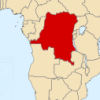Democratic Republic of Congo
(formerly Zaire)
Country Overview
The popular music of Congo has had a tremendous influence on African music
as a whole throughout last decades. The rumba, that has developed in colonial times, accompanied Congo into independence and songs like
« Independance Cha Cha », composed in 1960 by Joseph Kabasele Tshamala (le Grand Kalle),
one of the founding fathers of (modern) Congolese music,
had become an anthem of the national movement of Belgian Congo. During those last years before independence,
future stars began to play in various bands that were set up by nightclubs or wealthy businessmen. Apart from
le Grand Kalle's African Jazz there was of course the
OK Jazz with le Grand maître Franco. Music became an industry
with a high level of competition, and during the 1960s new bands and soloists appeared, such as Tabu Ley,
and Dr. Nico Kasanda's African Fiesta. Influences from Latin,
Carribean and soul music could be increasingly heard.
• 1970s
The 1970s brought about a more diverse musical sceneny with a younger generation musicians creating a wilder style, main exponents are Zaiko Langa Langa, Pepe Kalle's Empire Bakuba, and short-lived bands such as Lipua Lipua, Veve, and Bella Bella. As political and economic conditions in then Zaïre became worse, musicians migrated to either East Africa or West Africa (Togo, Côte d'Ivoire). In Tanzania and Kenya they had a large and lasting influence on music for decades.
• 1980s
In the 1980s, and partly influenced by a starting European interest in Congolese music (soukous), more and more singers and session musicians settled in Paris. Stars such as Koffi Olomide, Diblo Dibala, Soukous Stars and Quatre Etoiles were successful towards the end of the 1980s, early 1990s, also among audiences other than the Congolese.
• 1990s
The 1990s saw the rise of bands such as Wenge Musica, formed by then students, who would later split into several offshoots. Koffi Olomide remained popular, and in neigbouring Congo-Brazzaville, Extra Musica was quite successful. In the rest of Africa, the importance of Congolese music started to decline, although people like Awilo Longomba were popular in for instance Cameroon. The 21th century saw a decline in inspiration, but also a return to the original rumba.
• The Congolese Rumba
From the original rumba to later faster paced music such as soukous and ndombolo, the basis remains the rumba, but in many songs the tempo would shift halfway the song into the « sebene » making the songs extremely danceable through the rhythm, the highly-pitched solo guitars, backed by rhythm guitars and intermediate « mi-solo » guitar, a strong layer of drums, and, in an ideal world, a horn section. Also, the « animation », the shouts, are meant to incite the audience to dance.
• 1970s
The 1970s brought about a more diverse musical sceneny with a younger generation musicians creating a wilder style, main exponents are Zaiko Langa Langa, Pepe Kalle's Empire Bakuba, and short-lived bands such as Lipua Lipua, Veve, and Bella Bella. As political and economic conditions in then Zaïre became worse, musicians migrated to either East Africa or West Africa (Togo, Côte d'Ivoire). In Tanzania and Kenya they had a large and lasting influence on music for decades.
• 1980s
In the 1980s, and partly influenced by a starting European interest in Congolese music (soukous), more and more singers and session musicians settled in Paris. Stars such as Koffi Olomide, Diblo Dibala, Soukous Stars and Quatre Etoiles were successful towards the end of the 1980s, early 1990s, also among audiences other than the Congolese.
• 1990s
The 1990s saw the rise of bands such as Wenge Musica, formed by then students, who would later split into several offshoots. Koffi Olomide remained popular, and in neigbouring Congo-Brazzaville, Extra Musica was quite successful. In the rest of Africa, the importance of Congolese music started to decline, although people like Awilo Longomba were popular in for instance Cameroon. The 21th century saw a decline in inspiration, but also a return to the original rumba.
• The Congolese Rumba
From the original rumba to later faster paced music such as soukous and ndombolo, the basis remains the rumba, but in many songs the tempo would shift halfway the song into the « sebene » making the songs extremely danceable through the rhythm, the highly-pitched solo guitars, backed by rhythm guitars and intermediate « mi-solo » guitar, a strong layer of drums, and, in an ideal world, a horn section. Also, the « animation », the shouts, are meant to incite the audience to dance.
République Démocratique du Congo

Region:
Central Africa
Capital: Kinshasa
Official language: French
National languages:
Lingala, Kingwana (Swahili), Kikongo, Tshiluba
Main ethnic groups:
Mongo, Luba, Kongo, Mangbetu-Azande
Flags courtesy of ITA's Flags of All Countries used with permission.
Congolese Artist Pages
- Reddy Amisi
- Bana OK
- Bavon Marie Marie
- Pepe Bipoli
- Bokelo Blito
- Boketshu 1er & Classic Swede Swede
- Bopol
- Defao & le Big Stars
- Diblo Dibala & Matchatcha
- Djouna Big One
- Empire Bakuba
- Kester Emeneya & Victoria Eleïson
- Ferre Gola
- Fally Ipupa
- Kabosé
- Pépé Kallé
- Karma Pa
- Jeff Kavanda
- Kékélé
- Kino-Mabella
- Ricardo Lemvo & Makina Loca
- Lipua Lipua
- Lokua Kanza
- Awilo Longomba
- Lubumbashi Stars
- Lutchiana Mobulu 100%
- Madilu System
- Alain Makaba
- Manda Chante
- Sam Mangwana
- Jessy Matador
- Shiko Mawatu
- Syran Mbenza
- Mirage Supersonic - New !
- Nyboma
- Koffi Olomide
- Papa Noël
- Quartier Latin Academia
- Quatre Etoiles
- Tabu Ley Rochereau
- Trio Madjesi
- Bibi Den's Tshibayi
- Félix Wazekwa
- Papa Wemba
- Wenge Musica BCBG (J.B. M'Piana)
- Wenge Musica El Paris
- Wenge Kumbela (Aimé Buanga)
- Werrason & Wenge Musica Maison Mère
- Adolphe Dominguez & Wenge Tonya Tonya

